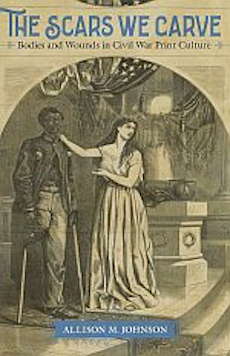By Louis J. Kern
Allison M. Johnson views the violent national rending by internecine war as universally traumatic for soldiers and civilians alike, producing physical, emotional, psychological, and social scars—a kind of national PTSD. Surveying a wide range of popular literature and imagery—newspapers, periodicals, letters, poems, and political cartoons—she argues that, contrary to traditional histories that viewed it from an exclusively masculinist perspective, the Civil War dissolved the boundaries between domestic and public, masculine and feminine, soldiers and the home front.
In this revisionist cultural history Johnson recuperates the contributions and endurance of the experience of extreme disruption, psychological devastation, and struggle for reintegration that have rarely found their way into accounts of the war—of women, African Americans, and amputees—and gives voice to issues of gender, race, and disability. Literarily, embodiment reflected the disruptive and subversive nature of felt experience; personal identities were reformulated, citizenship was redefined, and traditional binaries of male and female, white and black, and to a lesser extent disabled/incapacitated and physical wholeness were transcended.
The pervasive presence of allegorical female figures—Columbia, Liberty, Freedom—Johnson argues, prevented the exclusion of the feminine from the war. But this argument is undermined by the fact that the presence of these symbols bore traditional maternal traits—especially reassurance of domestic stability. When the statue of Freedom was installed on the Capitol (1863) journalists declared she had “waited and watched” affording a “guaranty of National Unity and Personal Freedom.” Meanwhile, 250 real women served in the army; many acted as recruiters or served as nurses. Perhaps a more telling expression of women’s role, especially in celebrating military service were the Ladies Memorial Associations (1865) and the United Daughters of the Confederacy (1874). Tellingly, the United Confederate Veterans was not founded until 1889 and the Sons of Confederate Veterans in 1896. In the North where the Grand Army of the Republic (1866) dominated, women were excluded from membership, and only the Daughters of Union Veterans (1885) was founded by women.
The Civil War’s impact on African Americans was epochal; 250,000 served as Union soldiers, experiencing transformation from object to subject from slave to soldier to citizen in the space of three years. A white officer posed the moral and political issue at the heart of black service; these men expected their full Constitutional rights, but many held they were “not intended for the Nigger.” As for himself, he saw the “status of poor Sambo” and championed “Freedom and the right of Voting.” Black soldiers fought for the Union and the deliverance of their people from bondage. Unfortunately, failed Reconstruction meant denial of their freedom, segregation, and lynching still clouding racial relations to the present.
As for disabled vets, Johnson discusses William Oland Bourne’s two Left-Handed Penmanship contests (1865) designed to reincorporate amputees as useful and viable citizens, encourage self-reliance, and prepare them for reintegration into the capitalist economy. As amputees struggled with fears of emasculation—incompetence and impotence—their condition was as marginalized as blackness. Given her concern for “spirit wounds and invisible bullets,” Johnson’s case would have been strengthened here by reference to neurologist Silas Weir Mitchell’s clinical report on “phantom limb” pain, first reported in a short story about a paraplegic, “The Case of George Dedlow” (Atlantic Monthly, July 1866).
Overall, this is a valuable addition to the popular history of the Civil War that effectively integrates the experiences too long under reported of women, African Americans, and amputees into a narrative of the conflict that breaches the wall that seeks to compartmentalize the wartime trauma of a severely scarred and wounded nation.
Louis J. Kern (ΦBK, Clark University) is professor emeritus of history at Hofstra University. Hofstra University is home to the Omega of New York chapter of Phi Beta Kappa.




